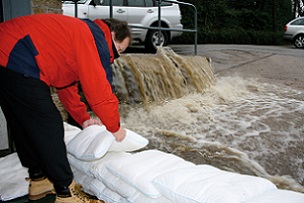
 A row of FloodSax alternative sandbags can keep out a torrent of fast flowing floodwater
A row of FloodSax alternative sandbags can keep out a torrent of fast flowing floodwater
What causes flash flooding and why are flash floods so dangerous?
Flash flooding has the potential to happen anywhere and at any time which gives homeowners and businesses very little time to react.
Sudden torrential rain which people sometimes refer to as a cloudburst can drop thousands of tonnes of water on an area in just minutes and, basically, the ground it lands on simply can’t cope with that huge amount of water suddenly descending on it.
Flash flooding – which can often happen during thunderstorms - is often caused when ground is bone hard dry or, ironically, already saturated with rain. Add in the possibility that drains and gulleys have not been cleared out by councils and you’ve a recipe for a flooding disaster. They often hit quite small areas so are impossible to predict but the consequences can be devastating.
Although officially defined as floods that can happen within six hours of heavy rain, flash floods often happen within minutes of a torrential downpour giving people very little time to react to get flood defences in place to save them from the catastrophic consequences of flooding.
The Met Office states: “Flash flooding happens when rain falls so fast that the underlying ground cannot cope, or drain it away, fast enough. Roads can become like rivers and if there is a lot of water it can flood buildings and carry cars away. So, if the rain is falling too fast for the ground or drains to cope there is a risk of flash flooding.
“Most rivers flow fairly gently as they slope slowly towards the sea. Therefore, when a river floods it does so quite slowly as it takes time for the rain to percolate through the ground and into the rivers and out to sea − allowing time for some warning. With flash flooding there is often very little time between the rain falling and flash flooding occurring.
“Flash flooding commonly happens more where rivers are narrow and steep so they flow more quickly. It can also occur away from small rivers in built-up urban areas where hard surfaces such as roads and concrete don’t let the water drain away into the ground. This leads to surface overflow and can often overwhelm local drainage systems leading to flash flooding.”
The most dramatic example of flash flooding in the UK in recent times happened in the village of Boscastle in Cornwall on August 16, 2004, when an exceptional amount of rain fell over eight hours.
Heavy thundery showers developed over the moors to the south west of Boscastle. A small, steep river flows though the village and the thundery showers came one after another in a short space of time, over the same spot at the head of the river. There was simply too much water for this small river and the surrounding hillside to cope with and the water gushed rapidly down the steep slopes into Boscastle.
Councils in the UK have no responsibility to provide sandbags and people are responsible for protecting their own homes and businesses from flooding. Some councils recommend FloodSax alternative sandbag flood barriers for flood protection which are a flexible alternative to traditional sandbags that are space-saving to store and quick and easy to deploy.
When FloodSax come into contact with water they absorb 20 litres which transforms them from being as light as a pillowcase to being more effective than traditional sandbags in just three minutes. Around 2.5 million have now been sold worldwide.